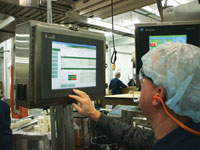
John Shaw, Litehouse IT director, checks out production scores on a CDC Factory screen. Source: Litehouse Foods.
In 2005, Litehouse started a continuous improvement program based on lean manufacturing practices and set out to improve performance without compromising customer service or product quality. Management recognized this effort would require a constant stream of accurate, real-time and actionable information-something Litehouse’s manual data-collection system was not providing.
“We’d often have lines going down 20 times during a run, but for only 30 or 40 seconds at a time,” said John Shaw, Litehouse Foods’ IT director. “Those stoppages quickly add up, but they weren’t being recorded. So we weren’t going after them. Maintenance would fix the problem, and we would just move on.”
Litehouse began to design its own shop floor data-collection system, but found it would require a sizable investment, take years to attain continuous improvement objectives and lack integration with the processor’s Ross ERP system. In October 2006, Shaw discovered CDC Factory software at a Ross customer conference. “I saw how CDC Factory could potentially do in six months what we had estimated would take us five years to accomplish with the other systems we were about to design in-house.”
Shaw and CDC personnel then began a detailed, three-day performance review in November 2006 at Litehouse’s Idaho plant. The analysis revealed Litehouse was operating at a 40% efficiency level-not the 60% the company had previously estimated. The report also showed that out of the 60% improvement opportunity, 8% inefficiency would always exist. A 52% opportunity for improvement remained in specific areas such as mechanical downtime, minor stops, hidden losses and setup time.
Management estimated obtaining just a quarter of the 52% efficiency improvement would deliver a return on investment (ROI) in less than 12 months. The company halted the design of the data-collection system and moved forward with the CDC software in December 2006. The system went live in the Michigan facility in April and in the Idaho facility in June.
The software’s impact on Litehouse’s production performance has been immediate and far-reaching. “Just the pure psychology factor alone-the fact that shop floor personnel knew we were now carefully looking at things such as start and stop times and downtime-led to increased output the very first week we used the system,” said Fred Alexander, manufacturing manager at Litehouse’s Michigan plant.
As of July 2007, output had increased on the main retail line by 47% per shift in the Michigan facility. “The impact of this improved output is significant,” added Shaw. Litehouse now produces in four days what used to take five, and since there is no longer a capacity issue, it doesn’t have to turn down new business or increase capital spending on new equipment. Litehouse has experienced a 15.5% reduction in labor costs at its Michigan facility, so it doesn’t need an extra crew to run another line. Shaw says Litehouse is on track to receive a full ROI in less than 12 months.
For more information: David Wain, CDC Software,
678-259-8456,dwain@cdcsoftware.com
